Swim Bladder 101: The Evolution Of The Fish’s Air Bladder
A swim bladder (also called an ‘air bladder’ or ‘gas bladder’) is a gas-filled bag that sits in a fish’s body cavity, above its guts.
The acquisition of a swim bladder, with the neutral buoyancy it gives to its possessors, was one of the crucial steps in the evolution of modern fish. Without it, fish would most surely be far less diverse – in terms of number of species and of the habitats they make use of – than they are today.
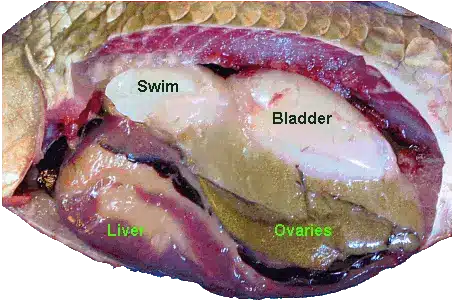
The earliest fishes, as well as modern cyclostomes, sharks and rays, all live without a swim bladder.
To do this, they either have to keep moving all day, every day… or, live on (or at least rest on) the sea floor. This is because a fish is heavy than the water it lives in – and it will sink if it stops swimming (unless it has a swim bladder).
Freshwater has a density of 1.0, saltwater has a density of 1.026 and a fish has a density of about 1.076 (this is an average figure). Also bone is nearly twice as dense as cartilage (1.1 vs 2.0), so before bony fish could become really successful, nature had to solve the problem of their density.
Swimming all the time is expensive in terms of energy and resting on the bottom is not always practical, especially in deeper waters. Furthermore, when you are using your fins to generate lift – and thus stop your self from falling to the bottom of the ocean – you can’t be using them for anything else.

Thus, the evolution of the swim bladder set fish free. They no longer had to keep moving forwards in order to stay at the level they wanted. And they could now use their fins to help them perform much more complicated manoeurvres, like staying still, swimming very slowly, turning on the spot, swimming head down, or head up, or even backwards.
Swim Bladder Evolution
Scientists believe that the swim bladder of modern fish evolved from a lung that early bony fish possessed.
Probably these fish lived in shallow tropical waters that had a low oxygen content – and which even have dried up in the summer, or dryer season. The possession of a lung allowed the fish to gain essential O2 from the air. When the environment these fish lived in changed, so that they no longer needed the lung to breath, nature slowly adapted it for its new role as a buoyancy organ.
Oxygen is much more plentiful in our air than it is in water. Even though the oxygen content of the atmosphere has varied over the millenia, this was also the situation when these fish were first evolving.
On average, in our modern atmosphere, there are about 210 cubic centimetres of O2 in one litre of air, as compared with 10 cubic centimetres in one litre of water.
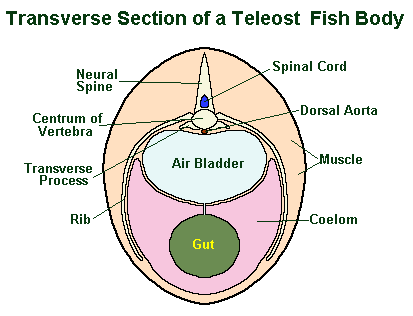
Keep in mind this is an average figure; the amount of oxygen water holds is dependent on its temperature and its surface area to volume ratio. Cold water holds more oxygen than warm water and white water – because of its greater surface area to volume ratio – holds more oxygen than blue water.
The microfauna/flora living in the water also play a role in regulating the O2 level of a body of water.
We human beings – and some ancient lineages of fish, such as the lungfish of South America and Africa – possess a ventral lung. Scientists believe that this was the original position of the lung.
However, for swimming fish, in comparison to fish which live on the bottom of a pond, a ventral lung is a problem – in that it makes the fish top heavy and liable to flip belly up.
Consider the problems you have trying to sit on top of a beach ball in the sea rather than merely hanging beneath it. Moving the lung, or swim bladder, to the most dorsal position possible made life much easier for fish.
That is why, in modern fish, the guts (see fish digestive system) always rest below the swim bladder in a fish’s body cavity. Nevertheless, they are still a little top heavy, which is why they sometimes float upside down when they are dead.
Air Bladder General Information
The air bladder of modern fish is an ellipsoidal, gas-filled sac that arises as an extension of the gut.
In many species of fish, the air bladder remains connected to the gut and the fish can use this connection to control the amount of gas in the air bladder. This is called the ‘Physostomous’ condition.
These sorts fish mostly live in shallow waters and swallow air at the surface of the water. This air is then passed into the guts and then forced into the air bladder. In some Physostomous fish, the air bladder is constricted near the middle to make it look like two sacs. However gas freely passes from one section to the other.
In other species, the connection with the gut is closed and no gas can be moved from the gut to the air bladder. This is called the ‘Physoclistous’ condition.
These fish are able to control the amount gas in their swim bladders, by means of one or more areas where the membrane is very thin and richly supplied with capillaries. Gas exchange is through the capillaries and the membrane.

The capillaries are both arterial and venous and they are arranged in a counter-current system, to facilitate the creation of high gas pressures within the swim bladder. These areas are known as ‘rete mirabile’, some physostomous species also possess one or more rete mirabile.
As sea water is more dense than freshwater (see above), the swim bladders of marine fish are smaller than those of fresh waters. On average, the swim bladder of a marine fish comprises 5% of its volume, whereas the swim bladder of a freshwater species will make up about 7% of its volume.
The gases fish use to inflate their swim bladders are those of the air around us, N2, O2 and CO2. However ,the proportions are not the same as in the atmosphere and vary between different species of fish.
Thus some deep-water marine fish species have up to 84% O2 in their swim bladder, while some deep-water freshwater species can have up to 94% N2 in theirs.
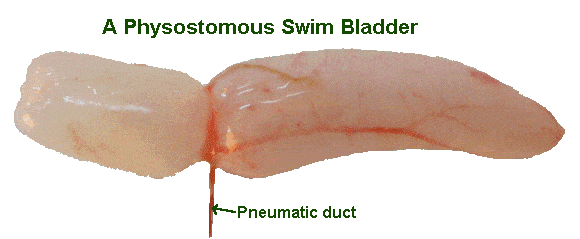
The ability to control the pressure within the gas bladder is essential to fish. The buoyancy their gas bladder gives them allows them to remain at a certain depth in the water without effort. However, because any given pressure of gas in their gas bladder is only neutrally buoyant for one specific depth, if they change their depth they have to change the pressure in their gas bladder.
The pressure exerted by the water on a fish increases by one atmosphere (14.7 psi) for every ten metres of depth. This means that while the pressure a fish experiences is 1 atmosphere at the surface, it is doubled to 2 atmospheres just ten metres down… and doubled again to 4 atmospheres at 30 metres down.
This increase in pressure compresses the gas in the fish’s gas bladder, so that at 10 metres it is only half as big as it was at the surface… and at 30 metres it is only one quarter as big.
Therefore to maintain neutral buoyancy, a fish must have twice as much gas in its gas bladder at ten metres depth as it has at the surface, and four times as much at 30 metres… and so on.
This is why physostomous fish give off bubbles as they come to the surface and take a gulp of air, before they dive down again. Obviously a fish rising from a depth of 30 metres needs to loose gas pressure quickly, if it desires to maintain neutral buoyancy. If it does not, it risks having its swim bladder greatly enlarged as the pressure is reduced.
This is why some fish, caught at a depth and brought quickly to the surface, have their swim bladder expanded to fill their throat and sometimes even extending beyond the mouth.
The Final Word
Nature is always creating diversity – which means changing things – and with 34,000 plus species to play with, there is plenty of diversity to be found amongst the fish.
Although it was the evolution of the swim bladder that allowed modern bony fish to conquer the lakes, seas and oceans of this world, many modern fish have given up their swim bladders. Foremost among these are many species which live their whole lives on the sea or ocean floor. Particularly those species which have partially sedentary lives, such as Blennies, Weavers and Flatheads.
Another type of fish that now has no swim bladder, are the highly energetic fish such as Tunny. They have oils in their body that help with buoyancy and they spend their whole lives actively swimming. For a fish that is always on the move and often changing depth quickly, a swim bladder would be more of a hindrance than a blessing, so they have simply learned to do without.
Perhaps now you’d like to learn more about fish anatomy.


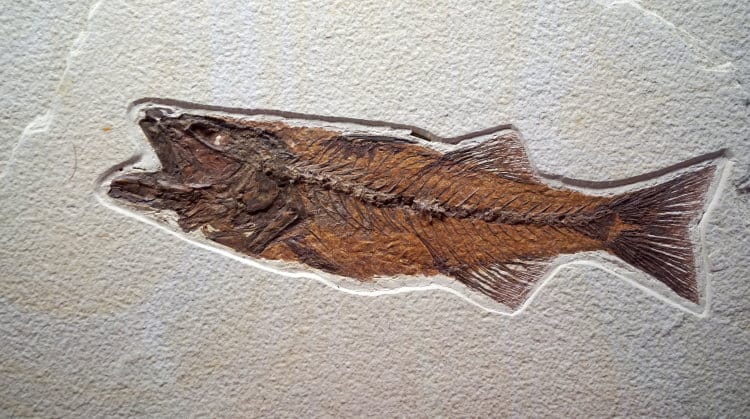
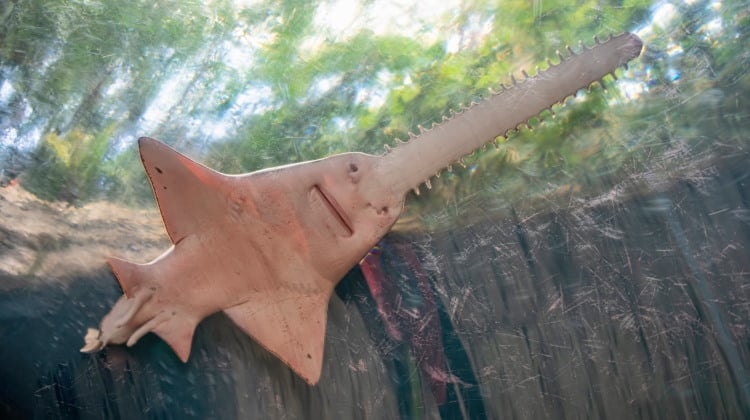

Sorry, Gordon. You have lots of great info here on swim bladders. I guess I’m reacting to your title when there is just the 1 tiny paragraph about what scientists believe about how it evolved. How about , “The Amazing Swim Bladder”? or something like that??
everything you have said is speculation. “probably evolved” means they don’t know. Why not just say it like that? Scientists “believe” is not a scientific statement, so why dress it up like it is?